This is an AI Free Zone! Text created by Large Language Models is spreading rapidly across the Internet. It's well-written, artificial, frequently inaccurate. If you find a mistake on Spaceweather.com, rest assured it was made by a real human being. | | |
SURPRISE GEOMAGNETIC STORM: Forecasters were surprised yesterday, June 28th, when a CME struck Earth and caused a severe (G4-class) geomagnetic storm. The CME was expected, but the severity of the storm was not; it was supposed to be a minor G1-class event. Daylight over Europe and the Americas hid a potentially dynamite display of auroras. Aurora alerts: SMS Text
NOCTILUCENT CLOUDS BLANKET EUROPE: This weekend, Europe is experiencing a widespread outbreak of noctilucent clouds (NLCs). Normally confined inside the Arctic Circle, the electric-blue wisps of frosted meteor smoke have been sighted as far south as Italy:
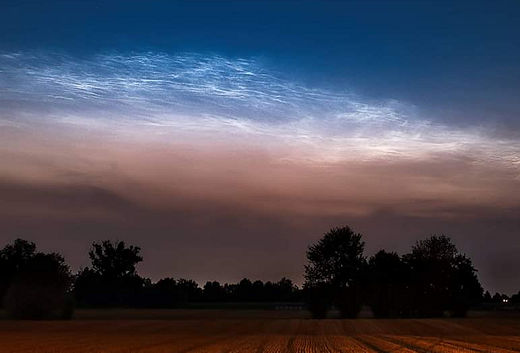
"It was a beautiful display," reports Fabrizio Marchi from Treviso, a city near Venice. "We are at +45 N, so the clouds have reached mid-latitudes."
Similar displays brightened the night skies of Austria, the Netherlands, Scotland, France, England, Lithuania, Croatia, Germany, Denmark, Belgium, Luxembourg, and Finland.
2024 is supposed to be a bad year for NLCs because Solar Max has arrived. High solar activity should melt these fragile clouds away. Two factors may be counteracting the sun.
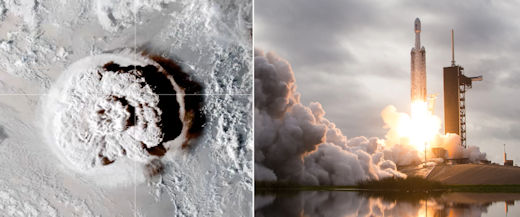
The Tonga undersea volcano (left) and a SpaceX Falcon Heavy launch (right)
First, there's Tonga. The undersea volcano erupted in January 2022, hurling record amounts of water into the atmosphere. That was two years ago, but it takes about two years for the vapor to circulate up to the mesosphere where NLCs form. Water is a key ingredient for NLCs, so Tonga's moisture could be turbocharging the clouds
Second is SpaceX. Studies show that water-rich rocket exhaust boosts the abundance of NLCs. So far this year (Jan. 1st - June 27th), 124 rockets have been launched, mostly by SpaceX. That's 4 times the rate of launches during previous Solar Maxima. Quadrupling the amount of rocket exhaust in the mesosphere might be enough to overwhelm the water and ice destroying effects of the active sun.
Realtime Noctilucent Cloud Photo Gallery
Free: Spaceweather.com Newsletter
THIS PENDANT HAS TOUCHED THE SHADOW OF THE MOON: On April 8, 2024, the students of Earth to Sky Calculus launched a cosmic ray research balloon directly into a total eclipse of the sun. This handmade pendant went along for the ride. Floating more than 118,110 feet above the path of totality in Texas, the necklace spent 3 minutes and 45 seconds wrapped in the shadow of the Moon:
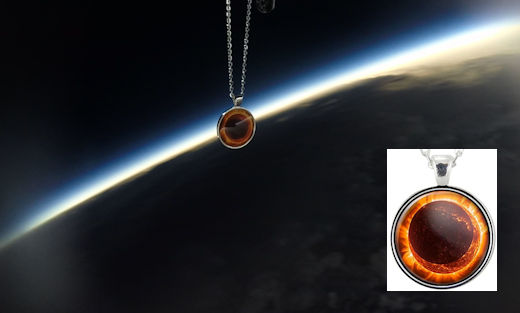
You can have it for $149.95. Created by an artist in Texas where the balloon was launched, the pendant displays a solar eclipse art print sealed under a smooth glass cover. It comes with a greeting card showing the pendant in flight and telling the story of its journey to the edge of space during the total eclipse.
Far Out Gifts: Earth to Sky Store
All sales support hands-on STEM education
CANYON OF FIRE: A filament of magnetism in the sun's southern hemisphere erupted today (June 29th). On its way to space, the plasma-filled strand cut a 'canyon of fire' in the sun's atmosphere:
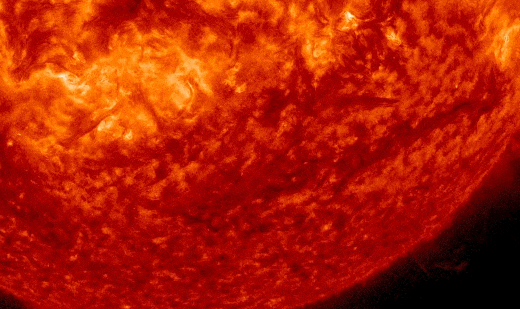
The contents of that canyon are now inside a coronal mass ejection (CME), seen here in a movie from SOHO coronagraphs. The bulk of the CME will pass south of Earth. However, its flank might deliver a glancing blow on July 2nd. Stay tuned for forecast models from NOAA. CME alerts: SMS Text
Realtime Space Weather Photo Gallery
Free: Spaceweather.com Newsletter
Realtime Comet Photo Gallery
Free: Spaceweather.com Newsletter
Realtime Aurora Photo Gallery
Free: Spaceweather.com Newsletter
Every night, a network of
NASA all-sky cameras scans the skies above the United States for meteoritic fireballs. Automated software maintained by NASA's Meteoroid Environment Office calculates their orbits, velocity, penetration depth in Earth's atmosphere and many other characteristics. Daily results are presented here on Spaceweather.com.
On Jun 29, 2024, the network reported 9 fireballs.
(9 sporadics)
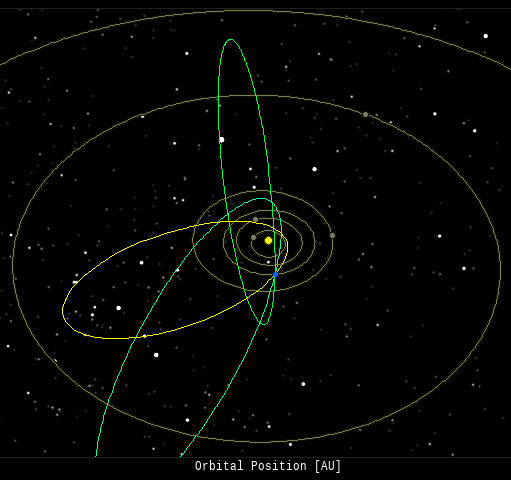
In this diagram of the inner solar system, all of the fireball orbits intersect at a single point--Earth. The orbits are color-coded by velocity, from slow (red) to fast (blue). [Larger image] [movies]
Potentially Hazardous Asteroids (
PHAs) are space rocks larger than approximately 100m that can come closer to Earth than 0.05 AU. None of the known PHAs is on a collision course with our planet, although astronomers are finding
new ones all the time.
On June 29, 2024 there were 2349 potentially hazardous asteroids.
 |
Recent & Upcoming Earth-asteroid encounters: | Asteroid | Date(UT) | Miss Distance | Velocity (km/s) | Diameter (m) |
| 2024 MU | 2024-Jun-24 | 18.7 LD | 6 | 22 |
| 2024 MD1 | 2024-Jun-24 | 4.9 LD | 7.2 | 23 |
| 2024 MV | 2024-Jun-25 | 1.2 LD | 7.4 | 16 |
| 2024 KJ | 2024-Jun-25 | 13.7 LD | 4.5 | 25 |
| 2024 LO5 | 2024-Jun-25 | 5.1 LD | 7.9 | 20 |
| 2019 NJ | 2024-Jun-27 | 17.2 LD | 10.1 | 66 |
| 415029 | 2024-Jun-27 | 17.3 LD | 25.9 | 2304 |
| 2022 MM1 | 2024-Jun-28 | 7.8 LD | 10.9 | 39 |
| 2010 XN | 2024-Jun-28 | 14.1 LD | 11.3 | 52 |
| 2024 MW | 2024-Jun-28 | 0.2 LD | 13.6 | 5 |
| 2022 HD1 | 2024-Jun-29 | 16.5 LD | 7.2 | 63 |
| 2024 MK | 2024-Jun-29 | 0.8 LD | 9.4 | 148 |
| 2017 MB3 | 2024-Jun-30 | 5 LD | 6.5 | 30 |
| 2024 JJ25 | 2024-Jun-30 | 10.5 LD | 9.4 | 117 |
| 2024 LJ2 | 2024-Jul-01 | 19.8 LD | 10.4 | 82 |
| 2022 BY39 | 2024-Jul-02 | 13.2 LD | 3 | 4 |
| 2024 LH | 2024-Jul-02 | 4.4 LD | 4.3 | 32 |
| 2024 KQ1 | 2024-Jul-04 | 14.9 LD | 6.9 | 57 |
| 2024 ME1 | 2024-Jul-10 | 11.4 LD | 8.4 | 39 |
| 2022 YS5 | 2024-Jul-11 | 11 LD | 5.8 | 38 |
| 2024 BY15 | 2024-Jul-16 | 16.2 LD | 0.7 | 16 |
| 2024 MG1 | 2024-Jul-22 | 11.1 LD | 9.3 | 55 |
| 2024 LY2 | 2024-Jul-23 | 12 LD | 7.8 | 87 |
| 2011 MW1 | 2024-Jul-25 | 10.1 LD | 8 | 120 |
| 2011 AM24 | 2024-Jul-26 | 16.8 LD | 6.2 | 281 |
| 523664 | 2024-Jul-28 | 14.9 LD | 23.7 | 680 |
| 2020 PN1 | 2024-Aug-02 | 18 LD | 5.5 | 29 |
| 2023 HB7 | 2024-Aug-05 | 14.6 LD | 6.1 | 32 |
| 2017 TU1 | 2024-Aug-05 | 10.1 LD | 10.1 | 22 |
| 2024 KH3 | 2024-Aug-10 | 14.6 LD | 11.4 | 197 |
| 2021 GY1 | 2024-Aug-16 | 17.7 LD | 6.3 | 59 |
| 2024 JV33 | 2024-Aug-19 | 12 LD | 11.1 | 213 |
| 2022 BF2 | 2024-Aug-19 | 19.7 LD | 16.4 | 91 |
| 2020 RL | 2024-Aug-27 | 12.2 LD | 8.2 | 34 |
Notes: LD means "Lunar Distance." 1 LD = 384,401 km, the distance between Earth and the Moon. 1 LD also equals 0.00256 AU. | | Cosmic Rays in the Atmosphere |
SPACE WEATHER BALLOON DATA: Almost once a week, Spaceweather.com and the students of Earth to Sky Calculus fly space weather balloons to the stratosphere over California. These balloons are equipped with sensors that detect secondary cosmic rays, a form of radiation from space that can penetrate all the way down to Earth's surface. Our monitoring program has been underway without interruption for 7 years, resulting in a unique dataset of in situ atmospheric measurements.
Latest results (July 2022): Atmospheric radiation is decreasing in 2022. Our latest measurements in July 2022 registered a 6-year low:
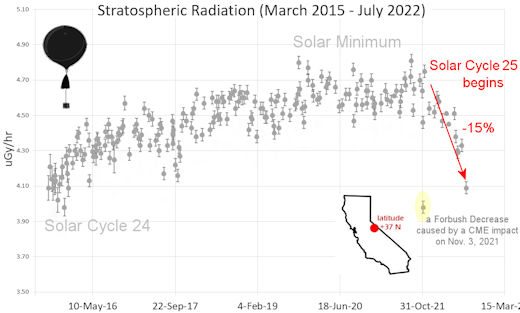
What's going on? Ironically, the radiation drop is caused by increasing solar activity. Solar Cycle 25 has roared to life faster than forecasters expected. The sun's strengthening and increasingly tangled magnetic field repels cosmic rays from deep space. In addition, solar coronal mass ejections (CMEs) sweep aside cosmic rays, causing sharp reductions called "Forbush Decreases." The two effects blend together to bring daily radiation levels down.
.Who cares? Cosmic rays are a surprisingly "down to Earth" form of space weather. They can alter the chemistry of the atmosphere, trigger lightning, and penetrate commercial airplanes. According to a study from the Harvard T.H. Chan school of public health, crews of aircraft have higher rates of cancer than the general population. The researchers listed cosmic rays, irregular sleep habits, and chemical contaminants as leading risk factors. A number of controversial studies (#1, #2, #3, #4) go even further, linking cosmic rays with cardiac arrhythmias and sudden cardiac death.
Technical notes: The radiation sensors onboard our helium balloons detect X-rays and gamma-rays in the energy range 10 keV to 20 MeV. These energies span the range of medical X-ray machines and airport security scanners.
Data points in the graph labeled "Stratospheric Radiation" correspond to the peak of the Regener-Pfotzer maximum, which lies about 67,000 feet above central California. When cosmic rays crash into Earth's atmosphere, they produce a spray of secondary particles that is most intense at the entrance to the stratosphere. Physicists Eric Regener and Georg Pfotzer discovered the maximum using balloons in the 1930s and it is what we are measuring today.
| | The official U.S. government space weather bureau |
| | The first place to look for information about sundogs, pillars, rainbows and related phenomena. |
| | Researchers call it a "Hubble for the sun." SDO is the most advanced solar observatory ever. |
| | 3D views of the sun from NASA's Solar and Terrestrial Relations Observatory |
| | Realtime and archival images of the Sun from SOHO. |
| | information about sunspots based on the latest NOAA/USAF Active Region Summary |
| | current counts of failed and deployed Starlink satellites from Jonathan's Space Page. See also, all satellite statistics. |
| | Authoritative predictions of space junk and satellite re-entries |
| | from the NOAA Space Environment Center |
| | fun to read, but should be taken with a grain of salt! Forecasts looking ahead more than a few days are often wrong. |
| | from the NOAA Space Environment Center |
| | the underlying science of space weather |
 | Got a chipped or cracked windshield that prevents you from seeing space weather events while driving? Get windshield replacement from SR Windows & Glass with free mobile auto glass service anywhere in the Phoenix area. |
 | Marketing yourself on YouTube is hard without real organic views on your videos. You can buy organic YouTube views from and enjoy social boosting that is actually real. Highly recommended! |
 | BestCSGOGambling is the best site for everything related to CSGO gambling on the web |
| | These links help Spaceweather.com stay online. Thank you to our supporters! |
| | | | | | |

